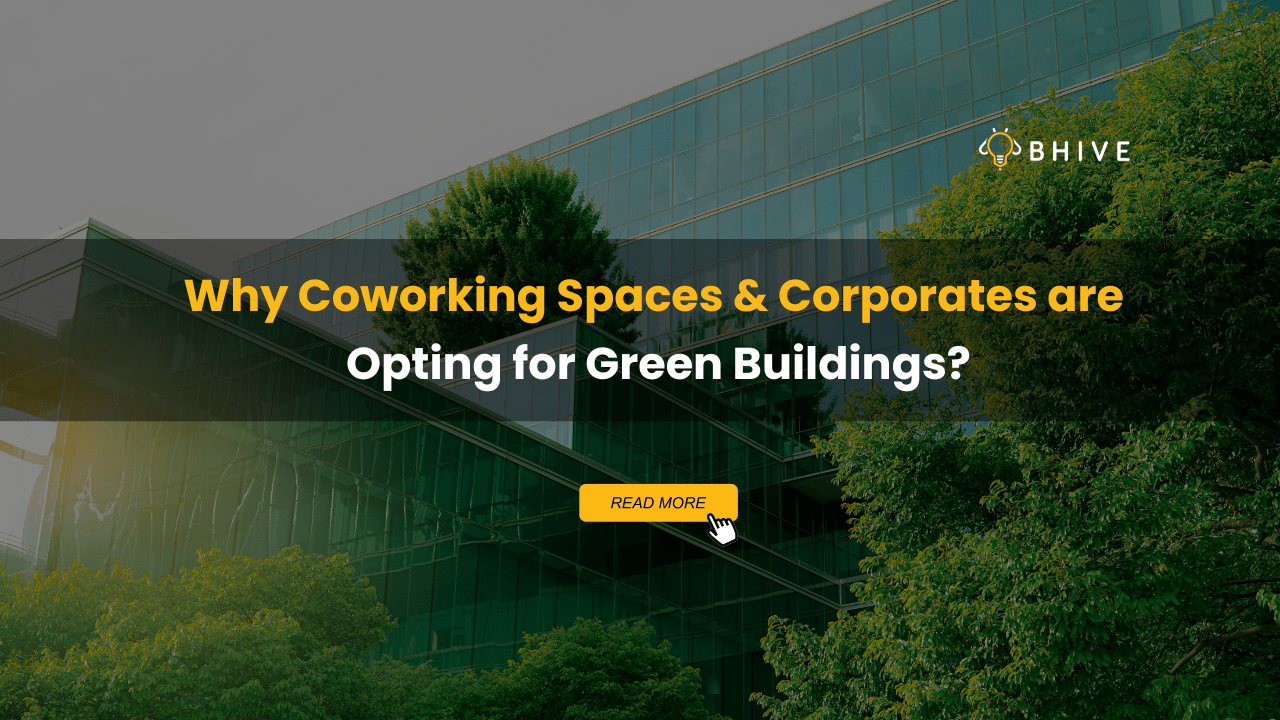Why Coworking Spaces and Corporates are Opting for Green Buildings?

In India, there has been an increase in the inclination of occupants to lease green buildings, so named because they are resource-efficient and environmentally conscious.
According to data released by real estate firm Colliers, 12.9 million square feet (msf) of office space was leased in green buildings in the top six Indian cities during the April–June quarter of this year.
Bengaluru has seen the largest leasing of green-certified office buildings since January 2023, with 16.5 msf. 11.8 msf in Delhi NCR and 11.2 msf in Chennai came next.
In terms of the total area occupied by green-certified office buildings since January 2023, the technology sector held the largest share of all sectors, at almost 27%.
Importance Of Sustainability In Modern Office Spaces
Businesses can reduce their carbon footprint by using sustainable office buildings. They save money on bills since they use less water and energy. These offices frequently have more natural light and higher air quality. Employees may feel happier and healthier as a result. An organization’s concern for the environment is demonstrated by its green certified offices. This might amaze clients and draw in top talent.
Many workers would rather work with companies that prioritize sustainability. It can improve a business’s reputation and make it stand out from competitors. Long-term financial savings are another benefit of sustainable design. Waste is reduced by energy-efficient technologies and smart building technology. This lessens the impact on the environment and helps preserve natural resources.
Benefits of Green Buildings
- Green buildings conserve natural resources like water and electricity.
- They have a sustainable design that ensures minimum wastage of land and other resources.
- They utilize renewable materials for construction and maximize the use of recycled materials.
- It reduces the carbon footprint by producing a lesser amount of waste.
- They improve indoor air quality and promote better health.
- Green building properties offer a better quality of life by facilitating natural living.
- Green buildings promote a safer environment by eliminating toxins.
Also read: A Sustainable Future with Coworking Spaces
Key Features of A Green Office
Design features that improve occupant well-being and lessen environmental impact are included into green buildings. These buildings emphasize sustainable office materials, effective resource usage, and a relationship with nature.
Energy Efficiency
Energy conservation is a top priority for green buildings. To use less electricity, they employ occupancy sensors and energy-efficient lighting, such as LEDs. Large windows reduce the demand for artificial lighting by maximizing natural light. Green buildings have very efficient HVAC systems. Using occupancy and weather data, they employ smart controls to optimize heating and cooling. Significant energy savings result from this.
Renewable energy sources are included into many green buildings. Clean electricity is produced locally by wind turbines or solar panels on roofs. This lessens carbon emissions and dependency on fossil fuels. Power consumption is further decreased by energy-efficient equipment and appliances. Green certified offices use equipment with the highest energy ratings for everything from laptops to kitchen appliances.
Use Of Renewable Materials
Sustainable office and recycled materials are used in the construction of green buildings. Bamboo is a popular material for flooring and furniture since it grows quickly and is renewable. Green workplaces give historic buildings’ reclaimed wood a new lease on life. It reduces the demand for new lumber by being used for walls, flooring, and decorative features.
Recycled steel, glass, and plastics are examples of eco-friendly materials. These lessen the requirement for fresh raw resources and trash. Sustainable office furniture composed of recycled or renewable materials is frequently found in green buildings. This carries over the building’s environmentally conscious philosophy into its interior areas.
Integration Of Nature
Biophilic design is a key feature of green buildings. Nature is incorporated into the constructed environment with this method. Green workplaces frequently have indoor plants. By removing contaminants and releasing oxygen, they enhance the quality of the air. Additionally, plants improve productivity and mood. Outdoor green areas are a common feature of green buildings. Landscaped areas, courtyards, and rooftop gardens offer spaces for unwinding and getting in touch with nature.
Vertical gardens on exterior or interior walls, known as living walls, are eye-catching elements. They enhance air quality, provide natural insulation, and establish a visual bond with the natural world. Frequently included are water elements like ponds or fountains. These components help to naturally cool the building and produce a peaceful ambiance.
Looking for a Coworking space? Read How to Discover Office Space for Rent in Bengaluru?
Latest Trends in Green buildings
Green office designs are becoming more and more popular worldwide. Modern technology is used to save energy in some of the most environmentally friendly office buildings. They have smart heating systems, solar panels, and rainwater collection. Using eco-friendly materials is a major focus of many new offices. They choose products that come from sustainable or recycled sources. By doing this, waste is reduced and forests and other natural areas are preserved.
Another popular trend is biophilic design. With its outside vistas, natural light, and plants, it invites nature into the office. People may feel more at ease at work and the air quality may improve as a result. Offices are going paperless thanks to digital tools. Instead of printing, a lot of businesses now use e-signatures and cloud storage. This lessens office clutter and saves trees.
Since 2012, energy-efficient green buildings have become more popular, especially in the business and corporate sectors. There are two primary reasons for this quick transition to green buildings:
- Low cost of operation.
- Enhanced health of the occupants.
In 2018, 27% of green construction projects were successfully implemented worldwide, according to the World Green construction Council. It is anticipated that over 60% of construction projects would transition to green building practices by 2021. Over the next three years, the green construction market in India alone is expected to reach a value of $35–50 billion.
Checkout our detailed LinkedIn article on How Sustainable Design in Bengaluru is Transforming Commercial Real Estate?
Why Are Coworking Spaces Shifting in Green Buildings?
Coworking spaces are attempting to provide individuals with an efficient and sustainable lifestyle as corporations recognize the necessity for green buildings in the future. In India, coworking spaces emerged as a fantastic response to the country’s growing construction rate, allowing numerous businesses, freelancers, and entrepreneurs to hire facilities for their daily operations.
They are currently paving the way for a secure future by switching to green buildings. In addition to achieving its economic and environmental objectives, an eco-friendly coworking space may enhance the productivity and well-being of its employees.
Why Are Corporates Exploring & Renting Offices in Green Buildings?
Building new structures poses a serious threat to the future of nations that are struggling to find enough natural resources and space for construction. Additionally, construction causes waste, toxicity, and undesired pollution that negatively impacts the ecosystem in multiple ways. Businesses can save a significant amount of energy and natural resources by moving to coworking facilities.
Based on their idea, design, operation, and performance, these buildings in India have been certified and rated by a number of organizations, including LEED India, IGBC Ratings, and BEE ECBC. The entire corporate sector’s future lies in a certified green coworking environment.
Also read: Sustainable Development: Building Eco-friendly Workspaces
References & Examples in India
Coworking Space in India are being developed by many top organizations in the corporate and commercial sectors, such as:
Suzlon One Earth, Pune
It is a LEED Platinum rated green building located in Pune, India. The building is constructed in a way that it conserves maximum energy by providing sufficient daylight and fresh air. It was designed by Charles Benninger.
Infinity Benchmark, Kolkata
This building in India was awarded the LEED certification for efficient energy conservation. The pollution levels in this building are checked using CO2 sensors. The insulated wall of this building keeps the interior cool, thus reducing the need for electrical cooling devices.
BHIVE Workspaces’ Commitment To Sustainability
Leading the way in environmentally friendly office solutions is BHIVE Workspaces. Their strategy blends staff well-being, energy efficiency, and environmentally friendly design. This makes areas that are good for the earth and people.
Sustainability is a key component of BHIVE Workspace designs. They build and furnish using low-impact and recycled materials. This lowers the carbon footprint and waste. Power consumption is reduced via HVAC and lighting technologies that utilize less energy. Depending on occupancy, smart sensors modify the lighting and temperature. Money and energy are saved in this way.
The well-being of employees is enhanced by green workplace areas. Healthy work environments are produced via air filtration systems, indoor plants, and natural light. These characteristics can decrease sick days and boost productivity. Tenants are also encouraged to adopt sustainable habits by BHIVE. They encourage paperless operations and offer recycling initiatives. This helps companies meet their own sustainability goals.
Green Building Features Of BHIVE Workspaces
BHIVE Workspace incorporates cutting-edge green technology in their buildings. Solar panels on roofs generate clean energy. Rainwater harvesting systems reduce water consumption. Advanced insulation and double-glazed windows minimize heat loss. This lowers heating and cooling costs. Green roofs and walls improve insulation and air quality.
Electric vehicle charging stations encourage eco-friendly commuting. Bike storage and shower facilities promote cycling to work. These features appeal to environmentally conscious employees and companies. BHIVE uses sustainable procurement practices. They source furniture and materials from eco-certified suppliers. This supports the wider green economy.Also Read: Innovative Office Design Ideas for Your Workplace
The Future of Work
As of June 2024, about 67 per cent of the Grade A office buildings in India were green-certified. Since January 2023, green buildings have accounted for 78 percent of all office space supply in the country.
According to ANAROCK, the real estate sector produces 40% of waste and 35% of greenhouse gases. Along with it, this sector also uses up more than 25% of water and energy resources. Unless we shift to green buildings now, our future is under significant threat. By installing green buildings, we can do our bit in maintaining the ecological balance on earth and make way to a safer future.
Frequently Asked Questions
Sustainable office spaces offer numerous benefits for businesses, employees, and the environment. They reduce carbon footprints, improve indoor quality, and provide economic advantages.
Businesses can reduce their carbon footprint in office spaces in many ways, including using renewable energy, improving energy efficiency, recycling, composting and choosing sustainable suppliers.
A green office design has several core features, including energy-efficient lighting, biophilic design, natural light, recyclable materials, indoor air quality, and renewable energy sources.
Eco-friendly workspaces can have many economic benefits, including lower operating costs, increased property values, attracting top talent, improved brand reputation, and preparing for future regulations.
Indoor environmental quality (IEQ) can significantly impact the health, comfort, and productivity of employees in sustainable offices. IEQ is a key aspect of sustainable architecture and includes factors such as:
Air quality
Lighting
Acoustics
Thermal comfort
Ergonomics
7 key strategies for promoting sustainability in the workplace:
Encourage remote and hybrid work.
Go paperless.
Conserve energy.
Conserve water.
Encourage sustainable transportation.
Reduce, Reuse, Recycle.
Become involved in the community.
Light it up with humour.
Technology can help make offices more sustainable and greener in many ways, including waste reduction, energy efficiency, carbon capture, renewable energy, and digital data.
Table of Content
- Importance Of Sustainability In Modern Office Spaces
- Key Features of A Green Office
- Latest Trends in Green buildings
- Why Are Coworking Spaces Shifting in Green Buildings?
- Why Are Corporates Exploring & Renting Offices in Green Buildings?
- References & Examples in India
- BHIVE Workspaces’ Commitment To Sustainability
- The Future of Work
- Frequently Asked Questions







